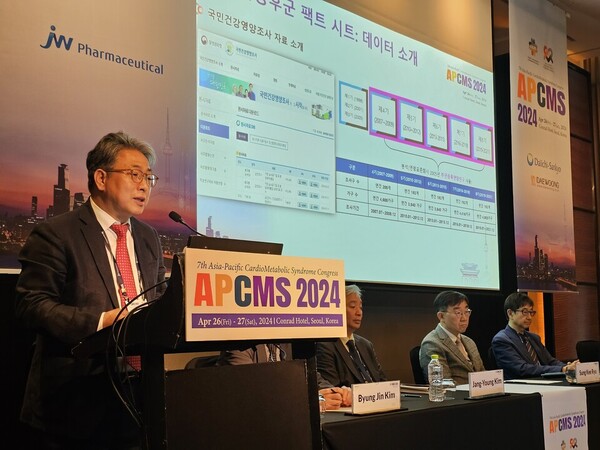The Covid-19 pandemic will end with the downgrade of the crisis level in May, but not without leaving a task for the government and the medical community -- the increased prevalence of metabolic syndrome.

The Korean Society of CardioMetabolic Syndrome (KSCMS) held a news conference at the Seventh Asia-Pacific CardioMetabolic Syndrome (APCMS 2024), held at the Conrad Seoul last Friday to introduce the background and major contents of the “Korean Metabolic Syndrome Fact Sheet 2024.”
KSCMS, which organized the conference under “Cardio-Metabolic Syndrome Fact Sheet 2024: Current Status of Cardio-Metabolic Syndrome and Changes Before and After Covid-19,” said, "Covid-19 has greatly affected our lives. We conducted extensive research to understand the changes in cardiometabolic syndrome before and after Covid-19."
The society used the 2005 population data from the National Statistics Portal as the basis for the factsheet. It analyzed data from the fourth to eighth National Health and Nutrition Examination Survey (2007-2021) to calculate age-standardized prevalence rates.
The definition of metabolic syndrome is based on the revised NCEP-ATP III diagnostic criteria for metabolic syndrome and the waist circumference criteria for abdominal obesity proposed by the Korean Society for the Study of Obesity (KSSO). It is defined as three or more of the following five criteria -- waist circumference, hypertriglyceridemia, low-density lipoprotein cholesterolemia, high blood pressure, and high blood sugar.
According to the factsheet, the prevalence of metabolic syndrome among adults aged 19 and older in Korea has steadily increased from 22.1 percent in the fourth survey period (2007-2009) to 24.9 percent in the eighth survey period (2019-2021), a steep increase compared to overseas. The main factor was the increase in the prevalence of abdominal obesity and hyperglycemia, which increased in all age groups of both sexes, with the highest prevalence among those aged 70 and older.
The prevalence of metabolic syndrome was 29.2 percent among those aged 30 years and older in the most recent eighth wave of the survey and 47 percent among those aged 65 years and older, with one in two having metabolic syndrome.
In addition, the prevalence gap between men and women is gradually widening. In the fourth round of the National Health Survey, the prevalence rate was about 2 percentage points higher in men, but the gap gradually widened, reaching 10.8 percentage points in the eighth round. For both men and women, the prevalence increased with age, with a sharp increase in men starting at a relatively young age of 30.
The prevalence of metabolic syndrome increased significantly after the Covid-19 pandemic, rising from 27.74 percent in pre-pandemic (2018-2019) to 29.69 percent in post-pandemic (2020-2021). This is likely due to people working from home and reducing their activities during Covid-19.
"We are looking for the cause of the increase in metabolic syndrome due to Covid-19 alone, even if other factors are fixed," said Professor Kim Hyun-jin of the Department of Cardiology at Hanyang University Guri Medical Center who also serves as the society’s medical information director, explaining the factsheet. "We are analyzing the data to document how the prevalence of metabolic syndrome has changed before and after Covid-19."
The prevalence of metabolic syndrome was also associated with poor lifestyle habits and socially disadvantaged groups. Lower household income and education levels were associated with a higher prevalence of metabolic syndrome, and the prevalence was higher among smokers, high-risk drinkers, and those who did not exercise regularly.
The society concluded that lifestyle modification is necessary to prevent cardiovascular disease and that active education and campaigns are needed.

Also noteworthy was the significant increase in the prevalence of metabolic syndrome in rural areas. The prevalence of metabolic syndrome is increasing across the country, and the increase is more pronounced in rural areas than in urban areas. In particular, the prevalence of metabolic syndrome has increased significantly in South Jeolla, North Chungcheong, and South Gyeongsang provinces.
"The increase in the prevalence of metabolic syndrome in rural areas was also evident in the Fact Sheet 2021, so we analyzed it separately," said Professor Kim Byung-jin of the Department of Cardiology at Kangbuk Samsung Hospital. "First, the main cause is the different lifestyles between urban and rural areas. Contrary to expectations, physical activity in rural areas is much lower than in urban areas because there are good sports facilities in cities, but not in rural areas."
Professor Kim continued, "In rural areas, each public health center conducts hypertension and diabetes registration and education programs. We have proposed that the government conduct a similar community-based metabolic syndrome project, but there has been no improvement."
Related articles
- Korea, China to collaborate on infectious disease management
- Covid-19 crisis to be downgraded to lowest 'attention' level starting in May
- Why does Korea lag behind Japan and Taiwan in long-term management of Covid-19?
- New AI model enhances mortality prediction in ECMO patients
- Medtronic Korea to directly sell diabetes management devices
- ‘Enhanced reimbursement for interventional procedures for severe heart disease will boost young physicians’
- ‘14% of Koreans have high blood pressure’
- Korea to start Covid-19 vaccinations in October
- Researchers develop tear-based Covid-19 biosensor using AI
- KDCA urges Covid-19 vaccination for high-risk groups amid rising cases in neighboring countries

